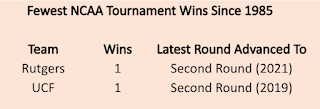Last week we looked at how Mountain West teams fared in terms of yards per play. This week, we turn our attention to how the season played out in terms of the Adjusted Pythagorean Record, or APR. For an in-depth look at APR, click here. If you didn’t feel like clicking, here is the Reader’s Digest version. APR looks at how well a team scores and prevents touchdowns. Non-offensive touchdowns, field goals, extra points, and safeties are excluded. The ratio of offensive touchdowns to touchdowns allowed is converted into a winning percentage. Pretty simple actually.
Once again, here are the 2023 Mountain West standings.
And here are the APR standings with conference rank in offensive touchdowns, touchdowns allowed, and APR in parentheses. This includes conference games only with the championship game excluded.
Finally, Mountain West teams are sorted by the difference between their actual number of wins and their expected number of wins according to APR.
No Mountain West teams saw their actual record differ significantly from their APR. Similarly, last week we saw that no Mountain West team saw their actual record differ significantly from their expected record based on YPP. The Mountain West was kind of boring in 2023 all things considered. What's Up with the Hawaii Bowl?
Since Christmas was on a Monday this past year, the Hawaii Bowl ceded its typical Christmas Eve spot to the NFL. But if you stayed up late on December 23rd, you would have seen something both amazing and mundane. Instead of a rotund Turkish bishop defying both the laws of time and physics you got to see yet another double digit underdog win outright in America's most exotic locale.
Coastal Carolina entered the Hawaii Bowl on a bit of a skid. After a 2-3 start gave way to a 5-0 run, the Chanticleers dropped their final two regular season games to Army and James Madison. The loss to the Dukes was not competitive. Couple that most recent data point with the continued absence of star quarterback Grayson McCall and the run that San Jose State was on entering the bowl game (six consecutive wins with five coming by double digits) and its easy to see why the Chanticleers were catching ten points in the betting markets. Despite those ominous signs, Coastal Carolina went up 17-0 in the fourth quarter and after a brief run by the Spartans cut the lead to three points, the Chanticleers put a final touchdown on the board to win by ten points. As I mentioned, this was amazing and mundane at the same time. I suppose amazing may be overselling it somewhat, but most college football fans, even partisan Coastal Carolina fans, probably would not have give their team much of a shot. That is of course, unless they had looked at the recent history of the Hawaii Bowl.
Since 2005, the Hawaii Bowl has seen the most upsets (tied with the Peach/Chick-Fil-A at ten) and most double digit upsets of any bowl game. Including Coastal Carolina in 2023, five underdogs of at least ten points have won the Hawaii Bowl. In 2007, East Carolina upset Boise State as a ten point underdog. In 2009, SMU blasted Nevada 45-10 as a twelve point underdog. One year later, Tulsa pummeled Hawaii as a ten point underdog on Hawaii's homefield. Finally, in 2012, SMU blasted another big favorite (Fresno State) as a thirteen point underdog. While the major upsets took a decade off before resuming with Coastal Carolina's victory in 2023, smaller underdogs won five of the eight Hawaii Bowls contested between 2013 and 2022 (the game was not played in 2020 or 2021). Here are the other bowl games that have seen more than one major upset since 2005.
Other bowl games can hang with the Hawaii Bowl in terms of overall upsets, but no game has seen more massive upsets. The Hawaii Bowl has accounted for twenty percent of all double digit bowl upsets since 2005! Is there a reason for this? Is the Hawaii Bowl uniquely suited for underdogs? I don't have a definitive answer, but I can think of a few possible explanations.
- Its not a major bowl game -- For all its charm, the Hawaii Bowl will never be confused with the Rose or Sugar Bowl in terms of national importance. This could mean the favorite doesn't take the game quite as seriously as they otherwise might. Which segues perfectly to...
- Distractions -- Hawaii is a beautiful place and though I've never been, I'm sure there are plenty of beautiful people on the island (both male and female), that could distract a young football player from the task at hand.
- Weird time slot -- The game is typically contested on Christmas Eve, although there have been a few exceptions in the game's history (including 2023). Regardless, the game is always played close to Christmas which could impact the team's preparation for the game.
- Unique travel -- Speaking of preparation, the game is a long way from the continental United State. A flight from Los Angeles to Honolulu takes nearly six hours. The long travel can certainly impact the internal body clocks of the players and coaches.
- Matchups -- In that list of major upsets in the Hawaii Bowl, all the losing teams were from the Group of Five. Despite entering as massive favorites, those Group of Five teams probably had talent levels that were similar to their opponents. They did not have a massive personnel advantage, which is the driving force behind most college football results.
I would love to hear your thoughts. Why has the Hawaii Bowl seen so many upsets? Is there a reason behind it or is this just noise?





























